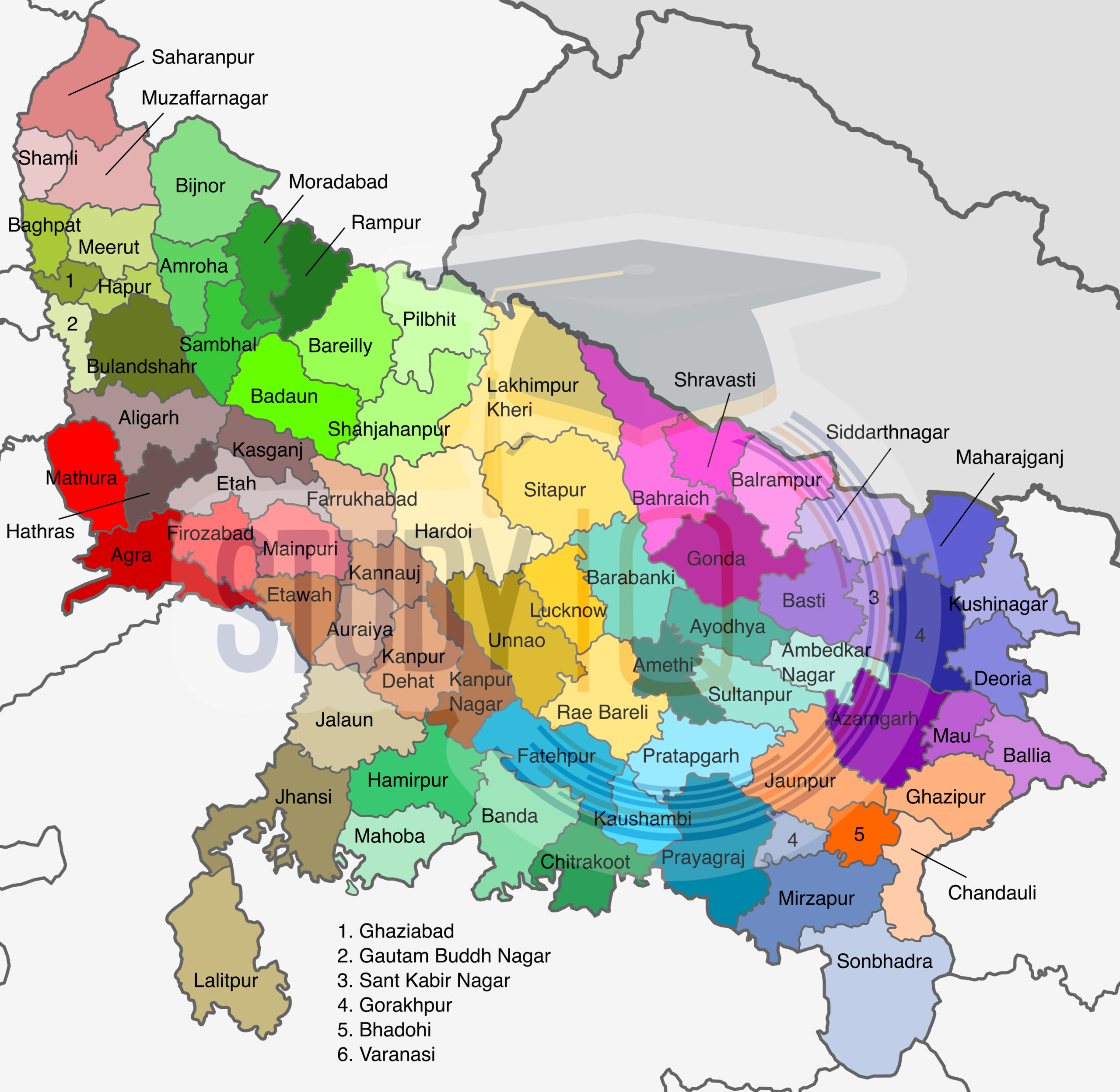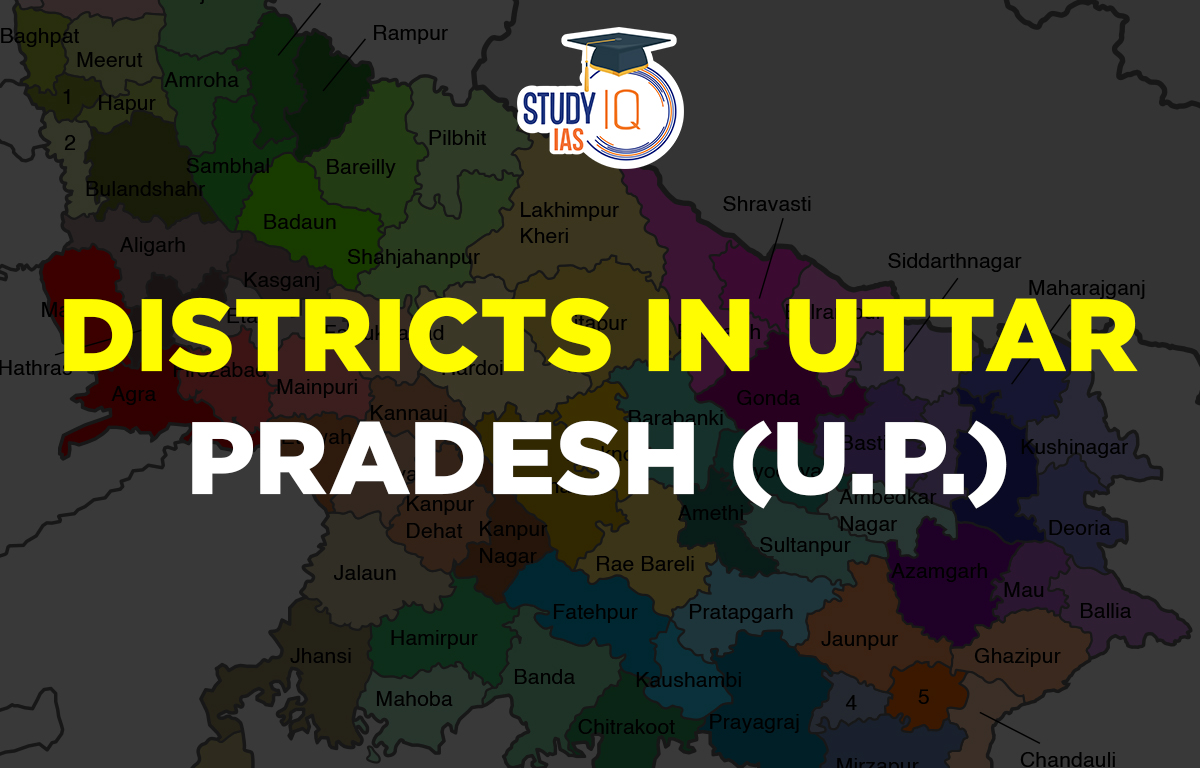Table of Contents
Districts of Uttar Pradesh
Uttar Pradesh is divided into 75 districts. Uttar Pradesh is India’s largest state, and it also has the most districts. A District Magistrate from the Indian Administrative Service governs each district in the state. Uttar Pradesh’s districts have divided into 18 administrative divisions for better administration. UP has a headquarters for each administrative division. The state’s total population exceeds 12 lakh people. Here, we have shared the number of districts in Uttar Pradesh, as well as some additional information about each district.
Read More: Districts of Telangana
How many districts are there in Uttar Pradesh?
Uttar Pradesh has a total of 75 districts. Uttar Pradesh is India’s covering a total area of 240,928 square kilometres. It was founded on January 24, 1950. A District Magistrate or Collector leads each district in Uttar Pradesh. A Superintendent of Police generally assists the DM in administering the state. Uttar Pradesh has always been India’s most populous state. Mayawati, the state’s then-Chief Minister, announced the creation of three new UP districts in 2011, Prabuddhanagar, Panchsheel Nagar, and Bhimnagar.
Read More: Districts of Karnataka
Districts of Uttar Pradesh Administrative Divisions
The divisionsis divided into which districts of Uttar Pradesh are shown in the table below. To learn more about the districts of UP, Check the table.
| Divisions | Headquarters | Uttar Pradesh Districts |
| Aligarh division | Aligarh |
|
| Agra division | Agra |
|
| Azamgarh division | Azamgarh |
|
| Prayagraj division | Prayagraj |
|
| Bareilly division | Bareilly |
|
| Basti division | Basti |
|
| Devipatan division | Gonda |
|
| Ayodhya division | Ayodhya |
|
| Chitrakoot division | Banda |
|
| Gorakhpur division | Gorakhpur |
|
| Kanpur division | Kanpur |
|
| Jhansi division | Jhansi |
|
| Lucknow division | Lucknow |
|
| Mirzapur division | Mirzapur |
|
| Meerut division | Meerut |
|
| Moradabad division | Moradabad |
|
| Varanasi division | Varanasi |
|
| Saharanpur division | Saharanpur |
|
Read More: Districts of Tamil Nadu
Map Of Uttar Pradesh Districts
On the map provided here, locate the locations of all the districts in Uttar Pradesh. Also, it will help you understand the state’s district sizes. See the image for a list of the districts still in existence in the state of Uttar Pradesh.

Read about: Districts of India
List Total District in UP
We have provided further details about each of Uttar Pradesh’s 75 districts in this article. The data includes the total area occupied by each district as well as its overall population. See the table below for further information about the districts of Uttar Pradesh.
| No. | District Name | Area | Population |
| 1 | Agra | 4,041 | 4,418,797 |
| 2 | Aligarh | 3,788 | 3,673,889 |
| 3 | Allahabad | 5,482 | 5,954,391 |
| 4 | Ambedkar Nagar | 2,350 | 2,397,888 |
| 5 | Amethi | 2,651 | 2,050,133 |
| 6 | Amroha | 2,249 | 1,840,221 |
| 7 | Auraiya | 2,016 | 1,379,545 |
| 8 | Azamgarh | 4,054 | 4,613,913 |
| 9 | Badaun | 4,234 | 3,127,621 |
| 10 | Bagpat | 5,237 | 1,303,048 |
| 11 | Bahraich | 2,981 | 3,487,731 |
| 12 | Ballia | 3,349 | 3,239,774 |
| 13 | Balrampur | 4,408 | 2,148,665 |
| 14 | Banda | 4,402 | 1,799,410 |
| 15 | Barabanki | 4,120 | 3,260,699 |
| 16 | Bareilly | 2,688 | 4,448,359 |
| 17 | Basti | 4,561 | 2,464,464 |
| 18 | Bijnor | 4,262 | 3,682,713 |
| 19 | Bulandshahr | 4,441 | 3,499,171 |
| 20 | Chandauli | 2,541 | 1,952,756 |
| 21 | Chitrakoot | 3,216 | 991,730 |
| 22 | Deoria | 2,540 | 3,100,946 |
| 23 | Etah | 2,431 | 1,774,480 |
| 24 | Etawah | 2,311 | 1,581,810 |
| 25 | Faizabad | 2,341 | 2,470,996 |
| 26 | Farrukhabad | 2,181 | 1,885,204 |
| 27 | Fatehpur | 4,152 | 2,632,733 |
| 28 | Firozabad | 2,407 | 2,498,156 |
| 29 | Gautam Buddha Nagar | 720 | 1,648,115 |
| 30 | Ghaziabad | 1,179 | 3,343,334 |
| 31 | Ghazipur | 3,377 | 3,620,268 |
| 32 | Gonda | 4,003 | 3,433,919 |
| 33 | Gorakhpur | 3,321 | 4,440,895 |
| 34 | Hamirpur | 4,021 | 1,104,285 |
| 35 | Hapur | 649 | 1,338,311 |
| 36 | Hardoi | 5,986 | 4,092,845 |
| 37 | Hathras | 1,840 | 1,564,708 |
| 38 | Jalaun | 4,565 | 1,689,974 |
| 39 | Jaunpur | 4,038 | 4,494,204 |
| 40 | Jhansi | 5,024 | 1,998,603 |
| 41 | Kannauj | 2,093 | 1,656,616 |
| 42 | Kanpur Dehat | 3,021 | 1,796,184 |
| 43 | Kanpur Nagar | 3,155 | 4,581,268 |
| 44 | Kasganj | 1,955 | 1,436,719 |
| 45 | Kaushambi | 1,779 | 1,599,596 |
| 46 | Kushinagar | 7,680 | 4,021,243 |
| 47 | Lakhimpur Kheri | 2,905 | 3,564,544 |
| 48 | Lalitpur | 5,039 | 1,221,592 |
| 49 | Lucknow | 2,528 | 4,589,838 |
| 50 | Maharajganj | 2,952 | 2,684,703 |
| 51 | Mahoba | 3,144 | 875,958 |
| 52 | Mainpuri | 2,760 | 1,868,529 |
| 53 | Mathura | 3,340 | 2,547,184 |
| 54 | Mau | 1,713 | 2,205,968 |
| 55 | Meerut | 2,559 | 3,443,689 |
| 56 | Mirzapur | 4,405 | 2,496,970 |
| 57 | Moradabad | 2,233 | 3,126,507 |
| 58 | Muzaffarnagar | 2,742 | 2,869,934 |
| 59 | Pilibhit | 3,686 | 2,031,007 |
| 60 | Pratapgarh | 3,717 | 3,209,141 |
| 61 | Rae Bareli | 3,937 | 2,903,507 |
| 62 | Rampur | 2,367 | 2,335,819 |
| 63 | Saharanpur | 3,689 | 3,466,382 |
| 64 | Sant Kabir Nagar | 2,390 | 2,199,774 |
| 65 | Sant Ravidas Nagar | 1,646 | 1,715,183 |
| 66 | Sambhal | 1,015 | 1,578,213 |
| 67 | Shahjahanpur | 4,388 | 3,006,538 |
| 68 | Shamli | 1,266 | 1,273,578 |
| 69 | Shravasti | 1,640 | 1,117,361 |
| 70 | Siddharthnagar | 2,895 | 2,559,297 |
| 71 | Sitapur | 5,743 | 4,483,992 |
| 72 | Sonbhadra | 6,905 | 1,862,559 |
| 73 | Sultanpur | 2,457 | 2,249,036 |
| 74 | Unnao | 4,558 | 3,108,367 |
| 75 | Varanasi (Kashi) | 1,535 | 3,676,841 |
List of Districts of Uttar Pradesh & their Importance
| S. No | District | Importance |
| 1 | Agra | Agra is famous for the Taj Mahal, one of the Seven Wonders of the World and a UNESCO World Heritage Site. |
| Agra is a major commercial center and is known for its leather goods, textiles, and handicrafts. | ||
| The city of Agra is known for its petha, a sweet made from ash gourd that is a popular local delicacy. | ||
| 2 | Aligarh | Aligarh is known for its lock industry, which produces a large percentage of the locks used in India. |
| Aligarh is home to the Aligarh Muslim University, one of the oldest and most prestigious universities in India. The city of Aligarh is famous for its cuisine, particularly its kachori and aloo gosht. | ||
| 3 | Allahabad (Prayagraj) | Allahabad is a major pilgrimage site for Hindus, and is home to the Kumbh Mela, the world’s largest religious festival. |
| The city of Allahabad is located at the confluence of three rivers: the Ganga, Yamuna, and Saraswati. Allahabad is known for its traditional arts and crafts, including the production of chikankari embroidery, glass bangles, and metalwork. | ||
| 4 | Ambedkar Nagar | Ambedkar Nagar is named after Dr. B.R. Ambedkar, one of the architects of the Indian Constitution. The district is known for its agriculture, particularly the production of sugarcane and wheat. |
| Ambedkar Nagar is home to several temples and historical sites, including the Baba Raghav Das Temple and the Shri Shiv Mandir. | ||
| 5 | Amethi | Amethi is the parliamentary constituency of former Indian Prime Minister Rajiv Gandhi. The district is known for its agriculture, particularly the production of rice and wheat. |
| Amethi is home to several educational institutions, including the Rajiv Gandhi Institute of Petroleum Technology and the Indira Gandhi Rashtriya Uran Akademi. | ||
| 6 | Amroha | Amroha is known for its handcrafted wooden toys, which are a popular local product. It is located on the banks of the Ganges River. |
| The district is home to several historical sites and monuments, including the Dargah of Shah Wilayat and the Naugaja Peer. | ||
| 7 | Auraiya | Auraiya is known for its textile industry, particularly the production of saris and dhotis. It is located on the banks of the Yamuna River. |
| The district is home to several historical sites and monuments, including the Pali Temple and the Durga Temple. | ||
| 8 | Azamgarh | Azamgarh district has a rich historical legacy and is known for its association with notable freedom fighters and leaders such as Raja Mahendra Pratap, Chittu Pandey, and Banwari Lal. |
| The district is also known for its literary heritage, and is the birthplace of several famous writers and poets including Alama Iqbal. | ||
| The district is home to several important Hindu, Muslim, and Buddhist pilgrimage sites such as the Ghazipur Shiva temple, the Nizamuddin Dargah, and the Buddha Stupa. | ||
| 9 | Baghpat | Baghpat is known for its agriculture, particularly the production of sugarcane, wheat, and rice. It is located on the banks of the Yamuna River. |
| The district is home to several historical sites and monuments, including the ancient town of Agroha and the Kali Temple. | ||
| 10 | Bahraich | Bahraich is known for its wildlife, and is home to several national parks and wildlife sanctuaries, including the Dudhwa National Park and the Katerniaghat Wildlife Sanctuary. |
| The district is also known for its agriculture, particularly the production of wheat, rice, and sugarcane. It is located on the banks of the Saryu River. | ||
| 11 | Ballia | Ballia is known for its cultural heritage, and is home to several historical sites and monuments, including the Bairiya Thakur Temple and the Turtipar Fort. |
| The district is also known for its agriculture, particularly the production of wheat, rice, and sugarcane. It is located on the banks of the Ganges River. | ||
| 12 | Balrampur | Balrampur is known for its rich history and culture, and is home to several historical sites and monuments, including the Devipatan Temple and the Shri Krishna Janmasthan. |
| The district is also known for its agriculture, particularly the production of sugarcane, wheat, and rice. It is located on the banks of the Rapti River. | ||
| 13 | Banda | Banda is known for its natural beauty, and is home to several scenic waterfalls, lakes, and forests. It is is also known for its traditional handicrafts, including weaving, embroidery, and pottery. |
| The city has a rich history and is home to several ancient temples, including the Banda Shiv Mandir and the Kali Khoh temple. | ||
| 14 | Barabanki | It is associated with important historical figures such as the Mughal Emperor Akbar and the revolutionary leader Mangal Pandey. |
| The district is also known for its scenic beauty and is home to several parks and gardens, including the Kukrail Forest Reserve and the Nawabganj Bird Sanctuary. | ||
| Barabanki is a major agricultural center and is known for its production of rice, wheat, and sugarcane. | ||
| 15 | Bareilly | Bareilly is known for its unique cuisine, which blends North Indian and Mughlai flavors. The city is famous for its seekh kebabs, biryanis, and tikkas. |
| The district is also known for its historical and cultural heritage, and is home to several ancient temples and monuments, including the Alakhnath Temple and the Dargah-e-Ala Hazrat. | ||
| Bareilly is a major commercial center and is known for its production of handicrafts, including zari work, embroidery, and leather goods. | ||
| 16 | Basti | Basti is known for its rich history and cultural heritage, and is home to several ancient temples and monuments, including the Basti Shiv Mandir and the Chhawani Kali Bari. |
| The district is also known for its scenic beauty, and is home to several natural attractions, including the Amritpur Wildlife Sanctuary and the Ghughuli Bird Sanctuary. | ||
| Basti is a major agricultural center and is known for its production of rice, wheat, and sugarcane. | ||
| 17 | Bhadohi (Sant Ravidas Nagar) | Bhadohi is known as the “Carpet City of India” and is a major center of the hand-knotted carpet industry. The district produces some of the finest carpets in the world. |
| The district is also known for its cultural heritage, and is home to several ancient temples and monuments, including the Sita Samahit Sthal and the Laxman Qila. | ||
| Bhadohi is a major commercial center and is known for its production of handicrafts, including pottery, weaving, and embroidery. | ||
| 18 | Bijnor | Bijnor is known for its natural beauty and is home to several scenic spots, including the Najibudaulah’s Fort and the Ramganga River. |
| The district is also known for its unique cuisine, which blends North Indian and Mughlai flavors. The city is famous for its pedas and kalakand sweets. | ||
| Bijnor is a major agricultural center and is known for its production of sugarcane, wheat, and rice. | ||
| 19 | Budaun | Budaun is known for its rich history and is home to several ancient monuments and landmarks, including the Jama Masjid and the Chathravritti Jain temple. |
| The district is also known for its natural beauty, and is home to several scenic spots, including the Sita Kund waterfall and the Sathianav Sagar bird sanctuary. | ||
| Budaun is a major agricultural center and is known for its production of wheat, sugarcane, and cotton. | ||
| 20 | Bulandshahr | Bulandshahr is known for its unique blend of Hindu and Muslim cultures, and is home to several historical monuments and landmarks, including the Dargah-e-Ala Hazrat and the Narora Dam. |
| The district is also known for its scenic beauty and is home to several parks and gardens, including the Neeraj Garden and the Solani Park. | ||
| Bulandshahr is a major agricultural center and is known for its production of wheat, sugarcane, and mustard. | ||
| 21 | Chandauli | Chandauli is known for its unique cultural heritage, and is home to several ancient temples and monuments, including the Ramna Kali Temple and the Latif Shah Baba Dargah. |
| The district is also known for its natural beauty, and is home to several scenic spots, including the Rajdari and Devdari waterfalls and the Chandra Prabha Wildlife Sanctuary. | ||
| Chandauli is a major industrial center and is home to several factories and industries, including thermal power plants and cement factories. | ||
| 22 | Chitrakoot | Chitrakoot is known for its religious significance and is home to several ancient temples and landmarks, including the Kamadgiri temple and the Hanuman Dhara waterfall. |
| The district is also known for its natural beauty, and is home to several scenic spots, including the Ram Ghat and the Gupt Godavari caves. | ||
| Chitrakoot is a major pilgrimage center and attracts thousands of tourists and devotees every year. | ||
| 23 | Deoria | Deoria is known for its religious significance and is home to several ancient temples and landmarks, including the Shiv Temple and the Baba Harihar Nath Temple. |
| The district is also known for its natural beauty, and is home to several scenic spots, including the Devariya Taal lake and the Ghaghra river. | ||
| Deoria is a major agricultural center and is known for its production of rice, wheat, and sugarcane. | ||
| 24 | Etah | Etah is known for its unique cuisine, which blends North Indian and Mughlai flavors. The district is famous for its pedas and kalakand sweets. |
| The district is also known for its cultural heritage, and is home to several ancient temples and monuments, including the Balaji temple and the Kali Mandir. | ||
| Etah is a major agricultural center and is known for its production of sugarcane, wheat, and mustard. | ||
| 25 | Etawah | Etawah is known for its unique cultural heritage, and is home to several ancient temples and landmarks, including the Chakreshwar Mahadev Temple and the Sankat Mochan Hanuman Mandir. |
| The district is also known for its natural beauty, and is home to several scenic spots, including the Saman Bird Sanctuary and the Lion Safari Etawah. | ||
| Etawah is a major industrial center and is home to several factories and industries, including a major oil refinery and a paper mill. | ||
| 26 | Ayodhya | Ayodhya is known for its rich history and is home to several ancient monuments and landmarks, including the Ramkatha Park and the Guptar Ghat. |
| The district is also known for its cultural heritage, and is home to several ancient temples and mosques, including the Hanuman Garhi temple and the Jama Masjid. | ||
| Ayodhya is a major pilgrimage center and attracts thousands of tourists and devotees every year. | ||
| 27 | Farrukhabad | Farrukhabad is known for its unique blend of Hindu and Muslim cultures, and is home to several historical monuments and landmarks, including the Sankisa Buddhist Stupa and the Nawabganj Bird Sanctuary. |
| The district is also known for its scenic beauty and is home to several parks and gardens, including the Bhainsroli Park and the Shyam Garden. | ||
| Farrukhabad is a major agricultural center and is known for its production of wheat, rice, and sugarcane. | ||
| 28 | Fatehpur | Fatehpur is known for its unique cultural heritage, and is home to several ancient temples and monuments, including the Bawan Bhitiya Temple and the Bari Karpur Devi Temple. |
| The district is also known for its natural beauty, and is home to several scenic spots, including the Bhitaura Lake and the Ganga Barrage. | ||
| Fatehpur is a major agricultural center and is known for its production of wheat, rice, and sugarcane. | ||
| 29 | Firozabad | Firozabad is known for its unique glass industry, which has been thriving for several centuries. The district is famous for its glass bangles and handicrafts. |
| The district is also known for its cultural heritage, and is home to several ancient temples and monuments, including the Shri Radha Krishna temple and the Shri Rangnath temple. | ||
| Firozabad is a major industrial center and is home to several factories and industries, including a major glass manufacturing plant. | ||
| 30 | Gautam Buddha Nagar (Noida) | Gautam Buddha Nagar is known for its modern and well-planned infrastructure, and is home to several multinational companies and business parks. |
| The district is also known for its educational institutions and is home to several prestigious universities and colleges, including the Amity University and the Jaypee Institute of Information Technology. | ||
| Gautam Buddha Nagar is a major commercial and industrial center and is known for its IT and electronics industries. | ||
| 31 | Ghaziabad | Ghaziabad is known for its strategic location and is a major transportation hub, connecting Delhi with several other cities and states. |
| The district is also known for its cultural heritage, and is home to several ancient temples and monuments, including the Shri Dudheshwar Nath Mandir and the Masuri Jain Temple. | ||
| Ghaziabad is a major industrial center and is known for its manufacturing industries, including steel, textiles, and chemicals. | ||
| 32 | Ghazipur | Ghazipur district is known for its contributions to the agricultural sector. The district is a major producer of crops such as wheat, rice, and sugarcane. |
| It is also known for its mango orchards and is home to the famous Dasheri mango variety. The district is also known for its folk traditions such as the Bhojpuri language and folk music. | ||
| 33 | Gonda | The district is known for its natural beauty and is home to several scenic spots, including the Kusumhi Forest and the Saryu River. |
| It has several monuments and landmarks, including the Swaminarayan Temple. It is known for its production of crops such as wheat, rice, & sugarcane. | ||
| 34 | Gorakhpur | Gorakhpur is known for its historical and cultural significance, and is home to several ancient temples and monuments, including the Gorakhnath Temple |
| The district is also known for its educational institutions and is home to several prestigious universities and colleges, including the Deen Dayal Upadhyay Gorakhpur University and the Baba Raghav Das Medical College | ||
| Gorakhpur is a major commercial and industrial center and is known for its production of goods such as furniture, brassware, and handloom textiles. | ||
| 35 | Hamirpur | The district has several ancient temples, including the Badi Devi Temple, which is believed to be more than 800 years old. |
| Hamirpur district has a rich cultural heritage, with a vibrant folk culture and several festivals celebrated with great enthusiasm. | ||
| The district is known for its traditional handicrafts, including pottery, wood carving, and weaving. | ||
| 36 | Hapur | Hapur is known for its strategic location and is a major transportation hub, connecting Delhi with several other cities and states. |
| The district is also known for its handicrafts and is a major center for the production of handloom textiles and pottery. | ||
| Hapur is a major industrial center and is known for its manufacturing industries, including steel, textiles, and chemicals. | ||
| 37 | Hardoi | The district has important eco tourist destinations in form of the Sandi Bird Sanctuary. The Gomati River flows mainly through Hardoi district. The river is an important water source for the district’s agriculture. |
| Hardoi has a major educational centers including the Hardoi Medical College. | ||
| 38 | Hathras | District is related to mother of Gautam Buddha, Mayadevi. |
| Hathras district is known for its agricultural production, particularly in wheat, and paddy. | ||
| The district of Hathras is primarily recognized for the production of the spice asafoetida, commonly known as “hing,” and also for the manufacturing of Desi Ghee products, which are the major industries in the region. | ||
| 39 | Jalaun | Jalaun district has a rich history, with several important historical sites, including the ancient city of Kalpi, which was an important center for Buddhism and Jainism. |
| The district is rich in mineral resources, particularly in limestone, which is used for cement production. Also known for its handicrafts, particularly in pottery & woodcarving | ||
| 40 | Jaunpur | The district is home to several tourist attractions, including the Atala Masjid, a 14th-century mosque built by Sultan Ibrahim Sharqi, and the Jahangirabad Fort. The economy of Jaunpur district primarily relies on agriculture due to the absence of heavy industry in the region. |
| There are several industries being established along the Varanasi-Jaunpur highway to boost economic growth in the district. | ||
| 41 | Jhansi | Jhansi Fort is a major tourist attraction known for its architectural beauty and historical significance. It is a symbol of India’s freedom struggle and played a crucial role in the Indian Rebellion of 1857. |
| Jhansi is an important railway junction connecting several major cities in North India, including Delhi, Mumbai, Kolkata, and Varanasi. The city is also well-connected by road and air. | ||
| Jhansi is an agricultural district known for its production of wheat, pulses, and oilseeds. | ||
| 42 | Kannauj | Kannauj is known as the “perfume capital of India” and has a rich tradition of making fragrances and perfumes. |
| Kannauj is a major producer of rose water, which is used for cooking, medicinal purposes, and in the perfume industry. | ||
| The district is famous for its fairs and festivals, including the Kannauj Rose Festival, which attracts visitors from all over the country. | ||
| 43 | Kanpur Dehat | The district has a thriving agricultural economy and dairy farming is also a significant source of income for many farmers. |
| Kanpur Dehat is home to many small-scale industries, including handloom weaving, pottery, and leatherwork. Former President of India Shri Ramnath Kovind is associated with this district. | ||
| 44 | Kanpur | Kanpur is a major industrial city and is known as the “Manchester of the East”. The district is home to the Indian Institute of Technology (IIT) Kanpur, one of the premier engineering institutes in the country. |
| The city has several historical landmarks, such as the Kanpur Memorial Church and the Kanpur Fort, which was built by the British in the 19th century. | ||
| 45 | Kasganj | The district was earlier named after Kanshi Ram, founder of Bahujan Samaj Party. Sant Tulsidas & Amir Khusro are notable personalities from Kasganj. |
| Kasganj is famous for its production of fine-quality buffalo milk ghee, which is exported to various parts of the world. | ||
| 46 | Kaushambi | The district is named after the Hindu sage Kusha, son of Lord Rama. |
| The district has several historical sites, including the ruins of the ancient city of Kaushambi, which was an important center of Buddhism during the Mauryan period. | ||
| Kaushambi is an important religious center, with several temples and shrines dedicated to Hindu deities such as Hanuman, Shiva, and Durga. | ||
| 47 | Lakhimpur Kheri | One of the largest districts in Uttar Pradesh and known as the “Sugar Bowl of India”. The district is home to largest sikh population in UP. |
| Dudhwa National Park, a wildlife reserve with rare species such as tiger, leopard, rhinoceros, and swamp deer, is located in the district. | ||
| 48 | Khushinagar | One of the major Buddhist pilgrimage sites with Mahaparinirvana Temple and Ramabhar Stupa. |
| Believed to be the place where Lord Buddha attained Mahaparinirvana. | ||
| Famous for its handloom industry and produces high-quality silk and cotton fabrics. | ||
| 49 | Lalitpur | The district is a major center for the production of ceramic and terracotta handicrafts. |
| The district is also known for its rich tradition of folk songs and dances such as Karma, Fag, and Raai. | ||
| The Dashavatara Temple, a Hindu temple dedicated to Vishnu, is situated in Deogarh, Uttar Pradesh, 25 kilometers away from Lalitpur. | ||
| 50 | Lucknow | The city is famous for its architecture, especially the buildings and monuments that were built during the period of the Nawabs of Awadh, including the Bara Imambara, Chota Imambara, and Rumi Darwaza. |
| Lucknow is also known for its cuisine, especially the Awadhi cuisine which is characterized by rich and flavorful dishes like biryani, kebabs, and kormas. | ||
| The city is a hub for education and research with several prestigious universities and research institutions located here, including the Indian Institute of Management Lucknow. | ||
| 51 | Maharajganj | Maharajganj is located in the northeastern part of Uttar Pradesh, sharing borders with Nepal on the northern side. |
| The district has several protected forests and wildlife sanctuaries, including the Sohagi Barwa Wildlife Sanctuary, which is home to endangered species like the Bengal Florican and the Great Indian Bustard. | ||
| Agriculture is the primary occupation of the people in the district, with rice, wheat, and sugarcane being the main crops grown. | ||
| 52 | Mahoba | Mahoba District in Uttar Pradesh, India, is famous for its 9th century granite Sun temple built in Pratihara style. |
| The district is also well known for the 24 rock-cut images of Jain tirthankaras on Gokhar hill. Also known for its rich mineral resources, including granite & Murrum. | ||
| 53 | Mainpuri | The town has prominent industries including cotton ginning, oilseed milling, and lamp and glass manufacturing. |
| There is a small but well-spread out peanut farming industry, and the town is known for its tobacco and wooden sculptures. | ||
| Siberian cranes visit Mainpuri’s Saman Bird Sanctuary for 3-4 months from November to February during migration. | ||
| 54 | Mathura | Mathura is a district in the western part of Uttar Pradesh, located approximately 150 kilometers south-east of Delhi. |
| Mathura is a city with rich cultural and religious significance, as it is considered to be the birthplace of Lord Krishna, a major Hindu deity. | ||
| Mathura Peda is a popular sweet which is in demand all over India. | ||
| 55 | Mau | Mau, which is also called Maunath Bhanjan, is an eastern UP industrial town. |
| Mau is known for its thriving handloom industry, with skilled weavers producing high-quality silk and cotton fabrics, especially Banarasi sarees and dress materials. | ||
| 56 | Mirzapur | Mirzapur is known for its handicrafts industry, especially its carpets, which are exported to various countries and are popular worldwide. |
| Mirzapur is a district located in the southwestern part of the state of Uttar Pradesh in India. It is situated on the banks of the Ganges river. | ||
| 57 | Meerut | It is situated approximately 70 kilometers northeast of the national capital, New Delhi. |
| Meerut is an industrial hub, with several manufacturing units producing textiles, sports goods, and agricultural implements, among other things. | ||
| It has a rich historical significance, with its association with the Indian War of Independence of 1857 and the famous Meerut Conspiracy Case of 1929. | ||
| 58 | Moradabad | Moradabad is known for its brass industry, which is one of the largest in the world, producing a wide range of brass handicrafts and decorative items. |
| It has produced famous writers & journalists like Neelesh Misra & Fazle Hasan Abedi. Located approximately 160 Km east of National Capital Delhi. | ||
| 59 | Muzaffarnagar | Muzaffarnagar is known for its sugar industry, with several sugar mills located in the district producing sugar, ethanol, and other by-products. |
| It has a rich sporting culture, especially in the field of wrestling, with several renowned wrestlers hailing from the district. | ||
| The Haiderpur wetland, which is situated within the Hastinapur Wildlife Sanctuary, is a UNESCO Ramsar site is located in this district. | ||
| 60 | Pilibhit | Pilibhit is located in the northern part of Uttar Pradesh and shares its borders with Nepal to the north. |
| It is home to the Pilibhit Tiger Reserve, which is one of the few remaining strongholds of the Bengal Tiger in India. | ||
| The district is home to several small and medium-scale industries, including paper mills, sugar mills, and cotton ginning factories. | ||
| 61 | Pratapgarh | Pratapgarh is primarily an agrarian district. It has a unique temple called Kisan Devta Mandir, which is the first of its kind in the world and is dedicated to farmers. |
| It is famous for being home to the endangered species of freshwater dolphins known as Ganga dolphins. | ||
| 62 | Raebareli | Raebareli is located in the central part of Uttar Pradesh and shares its borders with the districts of Lucknow, Unnao, and Pratapgarh. |
| Raebareli has major industries like NTPC and Modern Coach Factory, owned by Indian Railways. It also has AIIMS. | ||
| 63 | Rampur | Rampur is renowned for its spicy and flavorful cuisine, which offers a diverse range of dishes. |
| The Rampur knife is a cultural symbol and still crafted by skilled artisans for traditional Indian weapon enthusiasts. | ||
| Rampur is the third prominent school of poetry after Delhi and Lucknow, with legendary Urdu poets like Ghalib and Meenai receiving patronage from the Rampur court. | ||
| 64 | Saharanpur | Known for its cottage industries like wood carving, brass work, and weaving. |
| The district has a rich cultural heritage and is famous for its Sufi shrines and ancient temples. It is home to the Shivalik Hills and has a diverse range of flora and fauna. | ||
| 65 | Sant Kabir Nagar | It is notable for the location of the tomb and shrine of the poet Sant Kabir. |
| The district is known for its agriculture, with the major crops being sugarcane, wheat, and paddy. | ||
| 66 | Sambhal | Sambhal has a rich history and was a provincial capital during the period of Muslim rule under Sikandar Lodī in the late 15th and early 16th centuries. |
| The city serves as a trade center for agricultural produce and has industries including sugar refining, hand-loom weaving, and calico printing. | ||
| Sambhal hosts annual fairs for both Muslim and Hindu communities. | ||
| 67 | Shahjahanpur | Shahjahanpur is named after the Mughal emperor Shahjahan and is mainly inhabited by the Pathan community. |
| It is known for its cultivation of mango and guava crops, while also being recognized as one of the leading districts in the state for paddy production. | ||
| 68 | Shamli | Shamli was carved out of Muzaffarnagar. The city is known for its sugarcane cultivation and is one of the major producers of this crop in the region. |
| 69 | Sharavasti | It is known for its Buddhist heritage, as it was one of the major centers of Buddhism during ancient times. |
| The district is home to several important Buddhist pilgrimage sites, such as Jetavana Monastery and Anathapindika’s Stupa. | ||
| 70 | Siddharthnagar | It is named after Gautama Buddha, the founder of Buddhism. Siddharth was his childhood name. |
| The district is known for its rich cultural heritage and is home to several important monuments such as the Shobhnath Temple and the Naugarh Fort. | ||
| 71 | Sitapur | It is an important agricultural district known for its production of wheat, paddy, sugarcane, and mangoes. It is located in close proximity to capital of UP Lucknow. |
| 72 | Sonbhadra | Sonbhadra is a district located in the southeastern region of the Indian state of Uttar Pradesh, bordering Madhya Pradesh to the south and east. |
| Known for its rich mineral reserves, particularly coal, making it an important mining district in the state. | ||
| 73 | Sultanpur | Known for its rich history and cultural heritage, with many historic buildings and monuments located in and around the city. |
| Has a significant agricultural economy, with rice, wheat, and sugarcane among the major crops grown in the district. | ||
| 74 | Unnao | Famous for its leather industry, particularly the production of high-quality leather goods such as shoes and bags. Unnao is a district in central Uttar Pradesh, located 50km southeast of Lucknow. |
| 75 | Varanasi | Considered one of the holiest cities in India, with millions of Hindu pilgrims visiting each year to take a dip in the sacred Ganges River and perform religious ceremonies. Known for its rich cultural heritage, particularly in the areas of music, dance, and textiles. |
| Has a significant handloom industry, with Banarasi silk sarees being particularly famous and sought-after around the world. |


 World Hemophilia Day 2025: Theme, Histor...
World Hemophilia Day 2025: Theme, Histor...
 International Days List of 2025, Importa...
International Days List of 2025, Importa...
 Major Dhyan Chand Khel Ratna Award Winne...
Major Dhyan Chand Khel Ratna Award Winne...





















